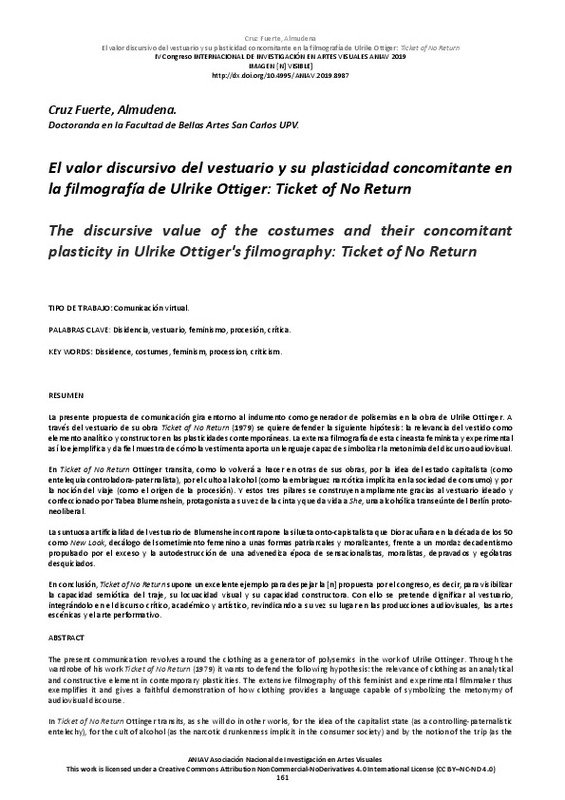|
Resumen:
|
[ES] La presente propuesta de comunicación gira entorno al indumento como generador de polisemias en la obra de Ulrike Ottinger. A
través del vestuario de su obra Ticket of No Return (1979) se quiere defender la siguiente ...[+]
[ES] La presente propuesta de comunicación gira entorno al indumento como generador de polisemias en la obra de Ulrike Ottinger. A
través del vestuario de su obra Ticket of No Return (1979) se quiere defender la siguiente hipótesis: la relevancia del vestido como
elemento analítico y constructor en las plasticidades contemporáneas. La extensa filmografía de esta cineasta feminista y experimental
así lo ejemplifica y da fiel muestra de cómo la vestimenta aporta un lenguaje capaz de simbolizar la metonimia del discurso audiovisual.
En Ticket of No Return Ottinger transita, como lo volverá a hacer en otras de sus obras, por la idea del estado capitalista (como
entelequia controladora-paternalista), por el culto al alcohol (como la embriaguez narcótica implícita en la sociedad de consumo) y por
la noción del viaje (como el origen de la procesión). Y estos tres pilares se construyen ampliamente gracias al vestuario ideado y
confeccionado por Tabea Blumenshein, protagonista a su vez de la cinta y que da vida a She, una alcohólica transeúnte del Berlín protoneoliberal.
La suntuosa artificialidad del vestuario de Blumenshein contrapone la silueta onto-capistalista que Dior acuñara en la década de los 50
como New Look, decálogo del sometimiento femenino a unas formas patriarcales y moralizantes, frente a un mordaz decadentismo
propulsado por el exceso y la autodestrucción de una advenediza época de sensacionalistas, moralistas, depravados y ególatras
desquiciados.
En conclusión, Ticket of No Return supone un excelente ejemplo para despejar la [n] propuesta por el congreso, es decir, para visibilizar
la capacidad semiótica del traje, su locuacidad visual y su capacidad constructora. Con ello se pretende dignificar al vestuario,
integrándolo en el discurso crítico, académico y artístico, revindicando a su vez su lugar en las producciones audiovisuales, las artes
escénicas y el arte performativo.
[-]
[EN] The present communication revolves around the clothing as a generator of polysemics in the work of Ulrike Ottinger. Through the
wardrobe of his work Ticket of No Return (1979) it wants to defend the following hypothesis: ...[+]
[EN] The present communication revolves around the clothing as a generator of polysemics in the work of Ulrike Ottinger. Through the
wardrobe of his work Ticket of No Return (1979) it wants to defend the following hypothesis: the relevance of clothing as an analytical
and constructive element in contemporary plasticities. The extensive filmography of this feminist and experimental filmmaker thus
exemplifies it and gives a faithful demonstration of how clothing provides a language capable of symbolizing the metonymy of
audiovisual discourse.
In Ticket of No Return Ottinger transits, as she will do in other works, for the idea of the capitalist state (as a controlling-paternalistic
entelechy), for the cult of alcohol (as the narcotic drunkenness implicit in the consumer society) and by the notion of the trip (as the origin of the procession). And these three pillars are widely constructed thanks to the costumes designed and made by Tabea
Blumenshein, protagonist in turn of the film and who gives life to She, an alcoholic passer-by from proto-neoliberal Berlin.
The sumptuous artificiality of Blumenshein's wardrobe contrasts the onto-capitalist silhouette that Dior coined in the 1950s as “New
Look”, a decalogue of female subjection to patriarchal and moralizing forms, in the face of a biting decadentism propelled by excess
and self-destruction of an upstart era of sensationalists, moralists, depraved and egotistical deranged.
In conclusion, Ticket of No Return is an excellent example to clear the [n] proposed by the congress, that is, to make visible the semiotic
capacity of the suit, its visual loquacity and its construction capacity. With this it intends to dignify the costumes, integrating them in the
critical, academic and artistic discourse, in turn claiming their place in audiovisual productions, performing arts and performative art.
[-]
|








